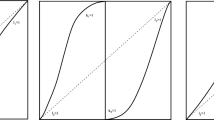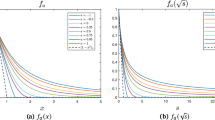Abstract
We describe the variation of the number \(N(t)\) of spatial critical points of smooth curves (defined as a scalar distance \(r\) from a fixed origin \(O\)) evolving under curvature-driven flows. In the latter, the speed \(v\) in the direction of the surface normal may only depend on the curvature \(\kappa \). Under the assumption that only generic saddle-node bifurcations occur, we show that \(N(t)\) will decrease if the partial derivative \(v_{\kappa }\) is positive and increase if it is negative (Theorem 1). Justification for the genericity assumption is provided in Sect. 5. For surfaces embedded in 3D, the normal speed \(v\) under curvature-driven flows may only depend on the principal curvatures \(\kappa , \lambda \). Here we prove the weaker (stochastic) Theorem 2 under the additional assumption that third-order partial derivatives can be approximated by random variables with zero expected value and covariance. Theorem 2 is a generalization of a result by Kuijper and Florack for the heat equation. We formulate a Conjecture for the case when the reference point coincides with the centre of gravity and we motivate the Conjecture by intermediate results and an example. Since models for collisional abrasion are governed by partial differential equations with \(v_{\kappa },v_{\lambda }>0\), our results suggest that the decrease of the number of static equilibrium points is characteristic of some natural processes.





Similar content being viewed by others
References
Alvarez, L., Guichard, F., Lions, P., Morel, J.: Axioms and fundamental equations of image processing. Arch. Ration. Mech. Anal. 123, 199–257 (1993)
Andrews, B.: Contraction of convex hypersurfaces in Euclidean space. Calc. Var. 2, 151–171 (1994)
Andrews, B.: Gauss curvature flow: the fate of rolling stones. Invent. Math. 138, 151–161 (1999)
Andrews, B.: Motion of hypersurfaces by Gauss curvature. Pac. J. Math. 195, 1–34 (2000)
Bloore, F.J.: The shape of pebbles. Math. Geol. 9, 113–122 (1977)
Bruce, J.W., Giblin, P.J., Gibson, C.G.: On caustics of plane curves. Am. Math. Mon. 88, 651–667 (1981)
Chow, B.: On Harnack’s inequailty and entropy for the Gaussian curvature flow. Commun. Pure Appl. Math. XLIV, 469–483 (1991)
Damon, J.: Morse theory for solutions to the heat equation and Gaussian blurring. J. Differ. Equ. 115, 368–401 (1995)
Domokos, G., Jerolmack, D., Sipos, A.A., Török, A.: How river rocks round: explinaining the size-shape paradox. PloS One (2014). doi:10.1371/journal.pone.0088657
Domokos, G., Lángi, Z.: On the equilibria of finely discretized curves and surfaces. Monatshefte für Mathematik 168, 321–345 (2012)
Domokos, G., Sipos, A., Szabó, G., Várkonyi, P.: Formation of sharp edges and plane areas of asteroids by polyhedral abrasion. Astrophys. J. 699, L13–L16 (2009)
Fidal, D.L., Giblin, P.J.: Generic one-parameter families of caustics in the plane. Math. Proc. Camb. Philos. Soc. 96, 425–432 (1984)
Firey, W.: The shape of worn stones. Mathematika 21, 1–11 (1974)
Grayson, M.A.: The heat equation shrinks embedded plane curves to round points. J. Differ. Geom. 26, 285–314 (1987)
Hamilton, R.: Three-manifolds with positive Ricci curvature. J. Differ. Geom. 17, 255–306 (1982)
Huisken, G.: Flow by mean curvature of convex surfaces into spheres. J. Differ. Geom. 20, 237–266 (1984)
Huisken, G.: Asymptotic behavior for singularities of the mean curvature flow. J. Differ. Geom. 31, 285–299 (1990)
Kardar, M., Parisi, G., Zhang, Y.-C.: Dynamic scaling of growing interfaces. Phys. Rev. Lett. 56, 889–892 (1986)
Kimia, B., Siddiqi, K.: Geometric heat equation and nonlinear diffusion of shapes and images. Comput. Vis. Image Underst. 64, 305–322 (1996)
Koenderink, J.: The structure of images. Biol. Cybern. 50, 363–370 (1984)
Kuijper, A., Florack, L.: The relevance of non-generic events in scale space models. Int. J. Comput. Vis. 57, 67–84 (2004)
Lanczos, C.: Linear Differential Operators. SIAM, Philadelphia (1996)
Leichtweiss, K.: Remarks on affine evolutions. Abh. Math. Sem. Univ. Hamburg 66, 355–376 (1996)
Loog, M., Duistermaat, J., Florack, L.: On the behavior of spatial critical points under Gaussian blurring: a Folklore Theorem and scale-space constraints. Scale-Space and Morphology in Computer Vision, Lecture Notes in Computer Science 2106, 183–192 (2001)
Lu, C., Cao, Y., Mumford, D.: Surface evolution under curvature flows. J. Vis. Commun. Image Rep. 13, 65–81 (2002)
Maritan, A., Toigo, F., Koplik, J., Banavar, J.: Dynamics of growing interfaces. Phys. Rev. Lett. 69, 3193–3195 (1992)
Marsilli, M., Maritan, A., Toigo, F., Banavar, J.: Stochastic growth equations and reparameterization invariance. Rev. Mod. Phys. 68, 963–983 (1996)
Mokhtarian, F., Abbasi, S., Kittler, J.: Efficient and robust retrieval by shape content through curvature scale space, pp. 35–42. In: International Workshop on Image Databases and Multimedia, Search (1996)
Mokhtarian, F., Suomela, R.: Robust image corner detection through curvature scale space. IEEE Trans. Pattern Anal. Mach. Intell. 20(12), 1376–1381 (1998)
Peitgen, H., Saupe, D., Schmitt, K.: Nonlinear elliptic boundary value problems versus finite difference approximations: numerically irrelevant solutions. J. Reine u. Angew. Math (Crelle) 322, 74–117 (1981)
Perelman, G.: Ricci flow with surgery on three-manifolds. http://arXiv.org/math.DG/0303109v1 (2003)
Poston, T., Stewart, I.: Catastrophe theory and its applications. Pitman, London (1978)
Rayleigh, L.: The ultimate shape of pebbles, natural and artificial. Proc. R. Soc. Lond. A 181, 107–118 (1942)
Rayleigh, L.: Pebbles, natural and artificial. Their shape under various conditions of abrasion. Proc. R. Soc. Lond. A 182, 321–334 (1944)
Rayleigh, L.: Pebbles of regular shape and their production in experiment. Nature 154, 161–171 (1944)
Turyn, L.: Spatial critical points of solutions of a one-dimensional nonlinear parabolic problem. Proc. AMS 106, 1003–1009 (1989)
Whiteside, D. (ed.): The Mathematical Papers of Isaac Newton, vol. 3. Cambridge University Press, Cambridge (1969)
Zeidler, E. (ed.): Oxford’s User Guide to Mathematics, p. 772. Oxford University Press, Oxford, New York (2004)
Acknowledgments
This work was supported by OTKA Grant T104601. The comments and suggestions from Zsolt Gáspár, Gary Gibbons, Phil Holmes and two anonymous referees are gratefully acknowledged. The author is very grateful to Zsolt Lángi for his invaluable help with computing the derivatives of the principal curvatures with the aid of Maple 16 and for his many other helpful comments.
Author information
Authors and Affiliations
Corresponding author
Electronic supplementary material
Below is the link to the electronic supplementary material.
Appendix
Appendix
First compute the three curves \(\beta ^G_1(\alpha ), \beta ^G_2(\alpha ), \beta _3(\alpha )\) in Fig. 4. We use the notations of Fig. 6. The curves \(\beta ^G_1(\alpha ), \beta ^G_2(\alpha )\) separate the domains with \(N=10\) and \(N=6\) critical points. We can compute these lines based on the conditions that the centre of gravity \(G\) should coincide with \(P_1,P_2\), respectively. In the case of \(G\equiv P_1\) we have to write moment balance to the horizontal line passing through \(P_1\):
and by substituting \(h=0.5\tan (\alpha )\), \(a=\tan (\beta )\) we get
In the case of \(G\equiv P_2\) we have
and by substituting \(h=0.5\tan (\alpha )\), \(a=\tan (\beta ), c=1/(2\tan (\alpha ))\) we get
which yields
For the invariant subspace we consider the geometry of the 5-gon where all edges are tangent to the largest inscribed circle and we can write
yielding
In the case of fixed reference point we choose the centre of the largest inscribed circle which is the ultimate point under Eikonal abrasion. To find the critical curves \(\beta ^{U}_i(\alpha ),(i=1,2)\) we write the conditions for \(U\equiv P_i\), yielding
Rights and permissions
About this article
Cite this article
Domokos, G. Monotonicity of Spatial Critical Points Evolving Under Curvature-Driven Flows. J Nonlinear Sci 25, 247–275 (2015). https://doi.org/10.1007/s00332-014-9228-3
Received:
Accepted:
Published:
Issue Date:
DOI: https://doi.org/10.1007/s00332-014-9228-3





